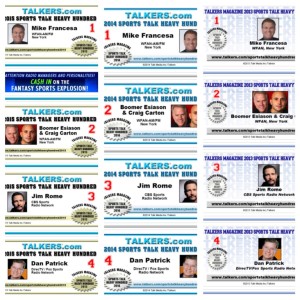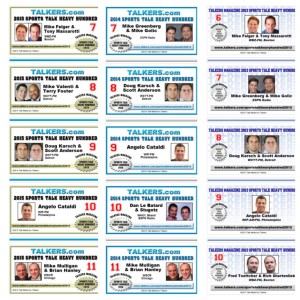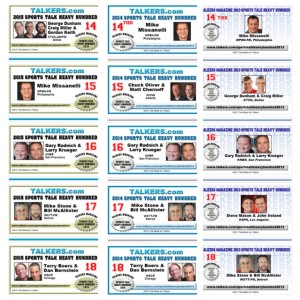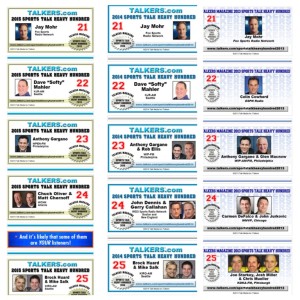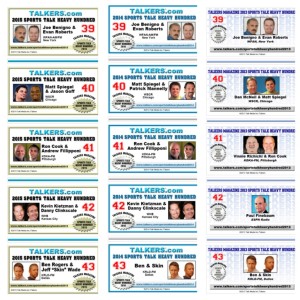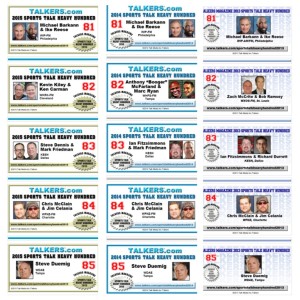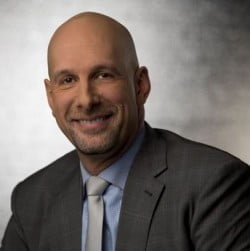On Thursday, Talker’s released its 4th annual Heavy Hundred of Sports Talk Radio, and as you’d expect it’s creating a lot of noise. Lists are very effective in terms of generating debate and discussion. When the focus becomes sports radio personalities and radio stations, that stirs even more emotion. Having created a few pieces like this myself, I know how subjective these things can be. So I recognize how difficult this project can be for the Talkers crew.
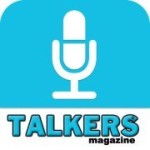 To assemble a piece like this and generate buzz is very easy. It’s the evidence though that supports each decision that determines if the list carries any weight. The outlet behind the piece also is important. There’s no question that Talkers has been a reputable source for talk radio for a long time. That’s why the “Heavy Hundred” creates interest throughout our industry. People in radio want to feel like their work is being recognized and measured by those who understand the challenges of doing it. Not by those who are uninformed or wearing rose colored glasses.
To assemble a piece like this and generate buzz is very easy. It’s the evidence though that supports each decision that determines if the list carries any weight. The outlet behind the piece also is important. There’s no question that Talkers has been a reputable source for talk radio for a long time. That’s why the “Heavy Hundred” creates interest throughout our industry. People in radio want to feel like their work is being recognized and measured by those who understand the challenges of doing it. Not by those who are uninformed or wearing rose colored glasses.
When I clicked on the link yesterday to review the list, I hoped to be pleased with the final result. I wanted to believe that quality research was done to showcase the industry’s best but once again I was left with more questions than answers. There also seems to be a bias directed towards certain shows, stations, and cities.
On Wednesday, Talkers posted on their website what some of their criteria was for the “Heavy Hundred”. They stressed that the final results are admittedly subjective and a number of factors determine who makes the cut. Which qualities mattered most though was not clear.
I thought it was worth researching to find out which criteria was most important and if the decision making was done in collaboration with different radio companies and programmers or if it was done independently. Many stations and industry professionals have been led to believe that there is a group of industry executives determining these results.
I started my investigation by reaching out to more than 50 Program Directors and Corporate Executives. I asked them how involved they were in sharing feedback with Talkers for their process. Only one Program Director said they had shared their input with the company. Whether Talkers asked for it or even considered it is unknown.
Next, I reached out to Talkers to get an idea of how they handle the process. The three questions I posed were:
- Who takes part in the selection committee for deciding the Top 100? (Are they strictly folks from the magazine/website or are managers from different radio groups included)
- Which factors matter the most in determining where you slot a show? (Ex: Ratings, Revenue, Market size, Longevity, etc.)
- If ratings are taken into account, are you looking at 6+, 12+ or the format’s key demo Men 25-54?
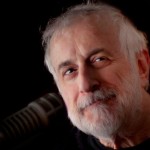 Michael Harrison, the company’s Editor and Publisher, didn’t address the questions directly but he did offer the publication’s perspective. He said “putting this list together is based on as much art and subjectivity as it is objective and empirical. In other words, this is not an “official” PPM-style ratings project based on a hard methodology – but rather, an impression based on a combination of information and opinions and that’s the way we want it to stay. Lists like this are thought-stimulators and not to be taken TOO seriously.”
Michael Harrison, the company’s Editor and Publisher, didn’t address the questions directly but he did offer the publication’s perspective. He said “putting this list together is based on as much art and subjectivity as it is objective and empirical. In other words, this is not an “official” PPM-style ratings project based on a hard methodology – but rather, an impression based on a combination of information and opinions and that’s the way we want it to stay. Lists like this are thought-stimulators and not to be taken TOO seriously.”
What Michael said in his last line is very important to be aware of. The list is meant to be a fun, thought provoking piece, that highlights the best in the format through the eyes and ears of the editors at Talkers Magazine. It’s not industry involved by design and whether a show finishes 1st or 100th, simply earning recognition from an industry resource like Talkers should make a talent and radio station feel good.
But therein lies the issue. Talkers has done a great job at building a brand that the radio industry values. They have a larger responsibility to showcase the industry properly. A fun subjective list that’s not to be taken seriously is something we should expect from our friends on Facebook. Not from one of the radio industry’s leading publications.
Yesterday after the list was released, I received five different press releases from radio stations pumping up their people who were on the “Heavy Hundred”. That tells me that the industry takes this list very seriously. One particular quote stood out. David Dickey with 680 The Fan in Atlanta said “We are thrilled that experts in the sports industry recognize The Fan as the most credible and most consumed sports station in Atlanta, airing some of the best sports-talk shows in the country”.
There’s one problem with that quote. Experts in the sports industry did NOT participate in this project. It was done independently by the editors at Talkers.
Being a former Program Director who studies this format as intently as I do, there are a couple of issues I believe need to be addressed. Most of the Talkers group are based on the East Coast. Call me cynical but I don’t believe they are listening to sports stations in the South, Midwest, or West Coast on a regular basis. Nor do I believe they are in tune with how impactful, successful or not successful, some of those brands and personalities are.
 I also know that gaining access to a station’s ratings and revenue is very difficult. Especially when you take into account that the key demo for the format (Men 25-54) isn’t made available to the public. You can dissect 6+ and 12+ numbers but those are not what accurately reflect a sports station’s performance. You can also see total revenue for a brand but that doesn’t tell you which personalities bring in the dough and which ones don’t.
I also know that gaining access to a station’s ratings and revenue is very difficult. Especially when you take into account that the key demo for the format (Men 25-54) isn’t made available to the public. You can dissect 6+ and 12+ numbers but those are not what accurately reflect a sports station’s performance. You can also see total revenue for a brand but that doesn’t tell you which personalities bring in the dough and which ones don’t.
As I analyzed the list, my initial impression is that many of the shows selected were chosen based on reputation of brand and longevity of show. I don’t believe ratings and revenue factored heavily into the equation as previously suggested. It feels more to me like “The Reputation 100” than a review of the best of 2015.
One other thing that I noticed that is very troublesome is that this list rarely changes. There’s no way in the world of radio ratings and revenue (where things change constantly) that you’re going to convince me that these shows have produced the same for the past 3 years. The only time you’ll see major changes are when shows no longer exist or guys who recently started with a station are lower one year and higher the next. Take some time and look at the lists for 2012, 2013, 2014, 2015. You’ll see a lot of the same results. Here is some photo evidence.
A few years ago one of my shows made this list and at that time the program had been on the air less than six months and was rated 17th in the market. Another show on my station which didn’t make the list, had spent 2-3 years together and was consistently rated in the Top 5. They were also our highest generating revenue program. I wasn’t asked nor was my General Manager for any information about our station or personalities ratings or revenue.
While that was then, let’s take a look at now.
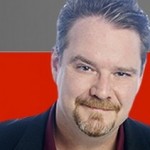 In San Francisco, Damon Bruce not only generates revenue for 95.7 The Game, but he’s been a Top 5 rated program throughout the past year. If you’re a Top 5 performer in the 4th largest market in America, how can you not be included as one of the industry’s Top 100?
In San Francisco, Damon Bruce not only generates revenue for 95.7 The Game, but he’s been a Top 5 rated program throughout the past year. If you’re a Top 5 performer in the 4th largest market in America, how can you not be included as one of the industry’s Top 100?
Talkers also said that in addition to ratings and revenue, a few other criteria were important. They included “effort, courage, uniqueness, recognition, impact and doing a show at the time of the list’s release”. Once again, Damon checks all of those boxes. So does Greg Papa and John Lund who work at the same station and have been in the Top 5 for the past 3 years and just finished #1 in October.
But that’s my former radio station so clearly I’m biased right? Well let’s switch coasts then.
Mark Madden does afternoons on 105.9 The X in Pittsburgh. He’s not on a full-time sports station, but he hosts a sports talk show for 4 hours a day in afternoon drive and delivers HUGE double digit ratings and revenue. He also possesses many of the attributes that Talkers said were important. He too though is not on the list. Three of the market’s shows on 93.7 The Fan made the list (deservingly so) so that eliminates any argument about the market being smaller.
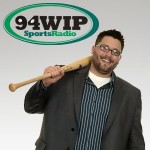 Staying in Pennsylvania, Josh Innes hosts afternoon drive on WIP in Philadelphia. He started in that slot in February with Tony Bruno and quickly the show was leading the afternoon ratings battle against Mike Missanelli who’s ranked 15th on the Talkers list. Bruno left the show in July which many thought would hurt the show. But WIP never lost momentum. Innes continued to win afternoons with a new crew.
Staying in Pennsylvania, Josh Innes hosts afternoon drive on WIP in Philadelphia. He started in that slot in February with Tony Bruno and quickly the show was leading the afternoon ratings battle against Mike Missanelli who’s ranked 15th on the Talkers list. Bruno left the show in July which many thought would hurt the show. But WIP never lost momentum. Innes continued to win afternoons with a new crew.
If I were to ask Andy Bloom who runs WIP, I’m sure he’d tell me their station is making a lot of money by finishing in the top spot in Philadelphia. If Innes is winning in afternoons, and doing so with two different versions of his program during the past calendar year, that should only further help his standing right? Nope. He’s rated 49th.
Missanelli is an exceptional talent and deserves to be in the Top 15. That’s not the issue. A host who’s on a heritage brand and in the same conversation for afternoon ratings and providing many of the qualities that the publication said were necessary shouldn’t be 34 spots away.
That same issue exists in Chicago where Waddle & Silvy (58th) on ESPN 1000 have won multiple months against Boers and Bernstein (18th) on The Score and in Kansas City where “The Drive” with Danny Parkins and Carrington “CDot” Harrison aren’t even on the list, despite doing a great show and leading the ratings against Kevin Keitzman (42nd) from WHB. How Michael Kay of 98.7 ESPN New York is relegated to 56th (third year in a row 55th or 56th) is another head scratcher.
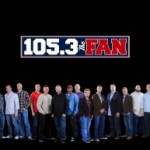 Moving south to Dallas, G-Bag Nation airs on 105.3 The Fan and is an incredible program. It beats The Ticket and ESPN 103.3 in middays and is often The Fan’s highest rated show. But once again, the show isn’t on the list. Their competitors who they beat consistently each month are. Norm Hitzges and Donovan Lewis from The Ticket are 79th and Steve Dennis and Mark Friedman are 83rd.
Moving south to Dallas, G-Bag Nation airs on 105.3 The Fan and is an incredible program. It beats The Ticket and ESPN 103.3 in middays and is often The Fan’s highest rated show. But once again, the show isn’t on the list. Their competitors who they beat consistently each month are. Norm Hitzges and Donovan Lewis from The Ticket are 79th and Steve Dennis and Mark Friedman are 83rd.
Ben & Skin (who are a really good show) work on the same station as G-Bag Nation and they finished 43rd despite delivering the same or lower numbers than the midday show. If G-Bag Nation produces the top ratings on their station, and beats the two shows (Hitzges & Lewis and Dennis & Friedo) that they line up against, then how are they left out?
Finally, I don’t need ratings evidence, only a good set of ears to know that Bomani Jones, Adam Schein and Dan Dakich are three of America’s best on-air talents. There’s no defense for them not being included. They are way too good to be left off.
In the grand scheme of things, this is only a list. We’re not dealing with a life threatening illness. But shouldn’t we expect some transparency when it involves voting on our entire industry? Is that too much to expect?
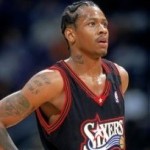 I remember when sports media people voted for MVP awards and made terrible decisions but couldn’t be held accountable because we didn’t know how they voted. Then two specific situations occurred and it’s been very different since. Fred Hickman voted for Allen Iverson as MVP over Shaq in 2000 and Keith Law placed Javier Vasquez above Adam Wainwright and Chris Carpenter in the 2009 NL Cy Young voting. Both men received a ton of backlash for their selections and with social media a major part of people’s lives now and accountability being important to the general public, it’s much harder to place a vote and hide.
I remember when sports media people voted for MVP awards and made terrible decisions but couldn’t be held accountable because we didn’t know how they voted. Then two specific situations occurred and it’s been very different since. Fred Hickman voted for Allen Iverson as MVP over Shaq in 2000 and Keith Law placed Javier Vasquez above Adam Wainwright and Chris Carpenter in the 2009 NL Cy Young voting. Both men received a ton of backlash for their selections and with social media a major part of people’s lives now and accountability being important to the general public, it’s much harder to place a vote and hide.
What frustrates me most is that people in our format really do care about this. They want to be measured fairly and some checks and balances would go a long way towards getting it right. Furthermore, there are stations using this information in local marketplaces to create confusion and present a false narrative for their brands and personalities. It’s similar to when a radio station runs a promo touting itself as America’s #1 sports station, when the truth is that they’re not even rated #1 in their own market. Just because you say something is factual doesn’t mean that it actually is.
The last part I want to draw attention to is SiriusXM. I recognize that the focus of this type of list is going to be on ‘terrestrial’ radio but if we’re identifying the Top 100 sports hosts in America, then shouldn’t they be included? Stephen A. Smith, Evan Cohen and Mark Packer aren’t good enough to make the Top 100? Chris Russo, despite having an entire channel named after him is only the 35th most important? Really?
 In talking to a number of Program Directors, they’re disappointed because they’re not asked about their shows and stations and they feel that Talkers aren’t privy to key information. I’ve often wondered why Program Directors weren’t interviewed as part of this process. Why consultants like Rick Scott, Tom Bigby and myself who follow the format nationwide and interact with stations and personalities aren’t asked to share a perspective. Why executives like Bruce Gilbert and Scott Masteller weren’t asked for feedback when they operated ESPN Radio and Fox Sports Radio and had regular communication with local stations across the country.
In talking to a number of Program Directors, they’re disappointed because they’re not asked about their shows and stations and they feel that Talkers aren’t privy to key information. I’ve often wondered why Program Directors weren’t interviewed as part of this process. Why consultants like Rick Scott, Tom Bigby and myself who follow the format nationwide and interact with stations and personalities aren’t asked to share a perspective. Why executives like Bruce Gilbert and Scott Masteller weren’t asked for feedback when they operated ESPN Radio and Fox Sports Radio and had regular communication with local stations across the country.
I’d think that Program Directors, Consultants, and Executives like Bruce, Mark Chernoff and Mike Thomas at CBS, Steve Cohen with SiriusXM, and Don Martin with Premiere/Fox Sports could lend some extra insight and information that would be beneficial. Some will say that by talking to them they’ll be biased towards their own people and while that’s probably true, they still have information that’s important. I’m not suggesting they be part of the final decision making process. That should absolutely belong to Talkers. But without knowing key details about many of these stations, it leaves a lot of industry people feeling like the list is very skewed and not well researched.
 If you’re an On-Air talent and you made the list, be appreciative towards the folks at Talkers who have highlighted your show and clearly value your work. However, just because you made the list, doesn’t mean you deserve a raise or that you should start bombarding other Program Director’s for bigger jobs because you’ve clearly established yourself.
If you’re an On-Air talent and you made the list, be appreciative towards the folks at Talkers who have highlighted your show and clearly value your work. However, just because you made the list, doesn’t mean you deserve a raise or that you should start bombarding other Program Director’s for bigger jobs because you’ve clearly established yourself.
I had one talent reach out to me two years ago and explain why I needed to hire them. They told me that based on their ranking on the Talkers Top 100, it was clear that the entire industry knew they were a difference maker. This individual didn’t finish in the Top 30 so when I responded by asking them “why should I hire you over all of the other shows that finished ahead of you” they didn’t take too kindly to my sarcasm. Now knowing that the survey is done independently by Talkers and without the involvement of the top radio minds in America, that same person may want to craft their wording a little differently.
I’m glad Talkers does this piece each year to give our format and our people some exposure. I know it’s a very hard list to assemble and everyone involved at the publication has to view this project as a love/hate assignment. No matter what they put out, there’s going to be some disagreement with it. By not providing transparency though with their process it leaves them open to additional criticisms.
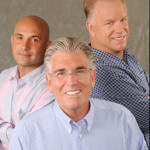 From where I sit, I don’t think you can find much room to argue with the Top 15-20. Personalities like Mike Francesa, Boomer & Carton, Jim Rome, Colin Cowherd and Dan Patrick deserve to be high on the list. In many ways this list reminds me of the NFL Draft. You can identify who the top prospects are but after Round 1 it’s a crapshoot and the great organizations do their homework and strike gold, while others miss the mark and ultimately pay the price for it.
From where I sit, I don’t think you can find much room to argue with the Top 15-20. Personalities like Mike Francesa, Boomer & Carton, Jim Rome, Colin Cowherd and Dan Patrick deserve to be high on the list. In many ways this list reminds me of the NFL Draft. You can identify who the top prospects are but after Round 1 it’s a crapshoot and the great organizations do their homework and strike gold, while others miss the mark and ultimately pay the price for it.
To those that made the list, congratulations. Whether you take it seriously or with a grain of salt, it’s a nice honor. The last thing I wanted to do was rain on Talkers parade but the process and research that goes into this should matter and industry people deserve to know who determines the results and what criteria matters most. Many assumed that top executives and programmers were involved in this process. But they’re not. They’ve also not been spoken to. If some additional conversation takes place, this list could become excellent and one that all groups look forward to being a part of.
For now though, the Talkers Heavy Hundred has become our Santa Claus. It started as a good idea that made us feel good inside, but the more we choose to believe in it, the more disappointed we become.
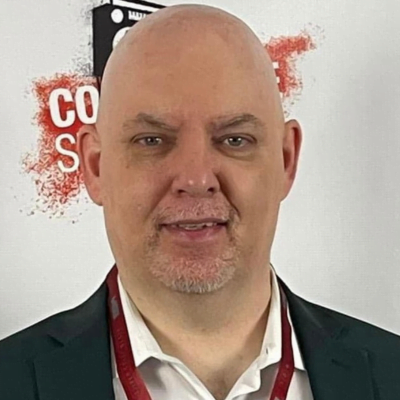
Jason Barrett is the President and Founder of Barrett Media since the company was created in September 2015. Prior to its arrival, JB served as a sports radio programmer, launching brands such as 95.7 The Game in San Francisco, and 101 ESPN in St. Louis. He also spent time programming SportsTalk 950 in Philadelphia, 590 The Fan KFNS in St. Louis, and ESPN 1340/1390 in Poughkeepsie, NY. Jason also worked on-air and behind the scenes in local radio at 101.5 WPDH, WTBQ 1110AM, and WPYX 106.5. He also spent two years on the national stage, producing radio shows for ESPN Radio in Bristol, CT. Among them included the Dan Patrick Show, and GameNight.
You can find JB on Twitter @SportsRadioPD. He’s also reachable by email at Jason@BarrettMedia.com.





